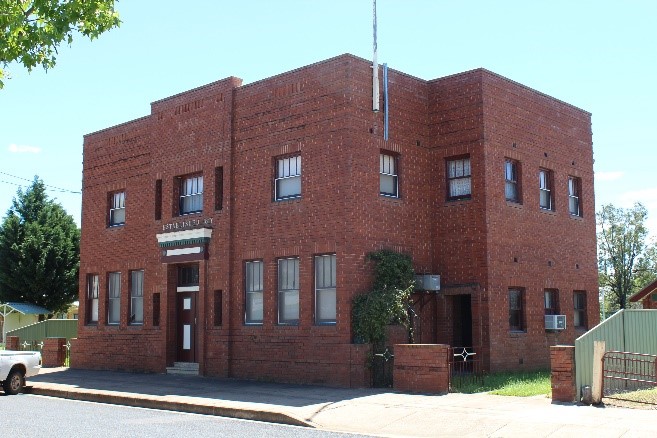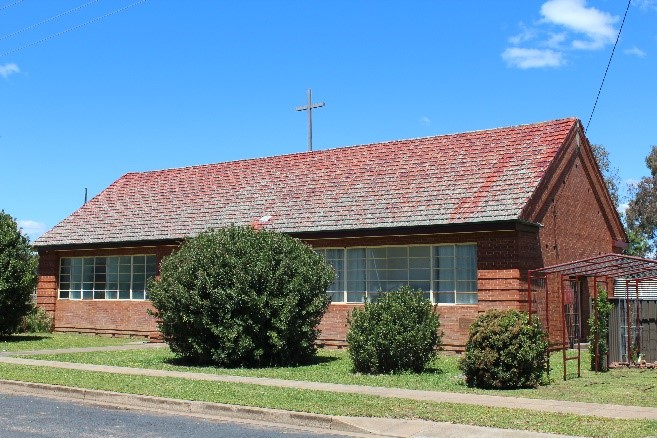1. Exchange Hotel

The Exchange Hotel has operated on its present site since the mid 1890s. It is the most substantial remaining element of the original business district of Binnaway, which had developed around Myall Street since the 1870s.
2. Binnaway Inn (former)

Binnaway stands on part of the Mowabla run occupied in 1848 by William Lawson. In 1877 Charles Naseby was the licensee of the Binnaway Inn. In 1888 John McWhirter took over the licence of the hotel until his death in 1892. Following the death of her husband Harriet McWhirter continued holding the licence to the Binnaway Inn which she transferred to the Exchange Hotel she had built in 1895. Now a private residence.
3. Railway Signals

The commercial centre of Binnaway was initially focused around Myall Street. After the coming of the railway the focus of the town shifted towards its current location along Renshaw Street. Members of the community have relocated various items of railway memorabilia, including signals and a station sign, to Renshaw Street to stand as a marker of the heritage of the town.
4. Bank of New South Wales (former)

In 1937 an allotment in Binnaway Street was purchased from J. Winter for £350. In 1938 this two-storey Art Deco style brick building was erected for the Bank of New South Wales at a cost of £5,789. The architect was thought to have been Gordon W. Lee of Newcastle. The manager at the time was Mr. T R Collis. Now a private residence.
5. Binnaway Post Office (former)

In 1876 the residents of Binnaway petitioned the Government recommending John McWhirter as postmaster for the developing village. John was the town’s first businessman and conducted a store, post office and butcher’s shop as well as the hotel. The official Binnaway Post Office opened in November 1939. The status of the Binnaway Post Office had previously been raised to an official office in 1938. Now a private residence.
6. Church of Saints Peter and Paul (former)

The building was originally constructed as a convent school run by The Sisters of Mercy. It was blessed and opened by Bishop Norton on October 22, 1939. The school was later converted to the Church of Saints Peter and Paul which relocated from the small brick chapel located immediately to the west of the former school building. This chapel building was constructed c.1924. Both the former school and chapel have been converted into residences.
7. Royal Hotel

The Royal Hotel was constructed in 1918 and stands as marker of the development that occurred in Binnaway after the coming of the railway in 1917. It also marks the shift of the central business district of the town from Myall to Renshaw Streets. The hotel was also the location for scenes of “The Shiralee” filmed in 1956. It is an intact example of Federation era design. Its first licensee was Mr E. Sheehan who operated the hotel in partnership with his wife.
8. Binnaway Soldiers’ Memorial Hall

Binnaway Soldiers' Memorial Hall was constructed in 1926 as a memorial to the men of the Binnaway district who served in World War I. It was funded by community subscription. Arthur Henry Manser constructed the building and operated a cinema in it for many years. The hall has continued to be used as a public meeting and entertainment place. A pre-school has been developed at the northern end of the hall.
9. Binnaway Union Church

The Binnaway Union Church is the only surviving union church in the Coonabarabran district. The church was built in 1926 through the combined efforts of the Anglican, Methodist and Presbyterian communities of Binnaway. The church is a good example of an inter-war Carpenter Gothic style church building and is a relatively rare example of its kind. Now a private residence.
10. Binnaway Railway Pumphouse

The branch line railway from Binnaway to Coonabarabran was opened on 11 June 1917. Steam locomotives required regularly placed coaling, watering and servicing facilities. The water tanks were filled from the Castlereagh River via the pumping station constructed on the bank of the river. The pumping plant was converted from oil to electricity in 1939. Steam locomotives were gradually displaced by diesel power in the early 1960s.
11. Railway Water Tanks

The Binnaway railway water tanks are a remaining element of the extensive infrastructure installed to service the needs of steam locomotives in the mid 20th century and are a visual icon of the importance of rail in the story of Binnaway. These cast iron water tanks were constructed near the locomotive depot to provide water for locomotives. An initial water supply of 20,000 gallons was expanded to 40,000 gallons in 1924.
12. Binnaway Railway Crew Barracks

‘Crew Barracks’ or ‘Rest Houses’ were established at regular intervals throughout the state to provide facilities for train crews to have a meal and some rest before returning home. The Binnaway Crew Barracks was constructed in 1924/25. The advent of dieselisation in the 1950s and 1960s increased train speeds and operating distances, thereby reducing the numbers of rest houses required. The barracks are now used as tourist accommodation.